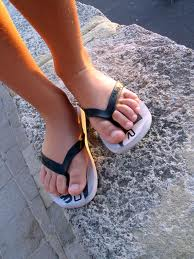 Now that the temperature has reached 90+ degrees, many people, especially teens and young adults, are sporting flip-flops. While flip-flops are certainly cooler and more comfortable to wear in the summer, they can cause a common, chronic inflammatory foot condition called plantar fasciitis – also known as flip-flop disease.
Now that the temperature has reached 90+ degrees, many people, especially teens and young adults, are sporting flip-flops. While flip-flops are certainly cooler and more comfortable to wear in the summer, they can cause a common, chronic inflammatory foot condition called plantar fasciitis – also known as flip-flop disease.
Podiatrists have seen more cases of plantar fasciitis in 15- to 25-year-old patients as the popularity of flip-flops has increased. This can be attributed to the fact that teens and young adults are wearing flip-flops everyday – all day. While flip-flops are great to wear to the beach or at the pool, podiatrists will tell you they were never meant for everyday use.
How Do Flip-Flops Cause Plantar Fasciitis?
The plantar fascia is a thick band of tissue that runs from your heel bone across the bottom (or plantar side) of your foot to your toes, connecting to the metatarsal joints. Normally, the plantar fascia pulls on the heel bone and maintains the arch of your foot as it lifts off the ground. However, if your foot moves incorrectly, the plantar fascia may become strained, causing pain and inflammation.
Flip-flops can be thin and flimsy with little to no padding between your feet and the ground. Also they provide little to no arch support for your feet. When you stand or walk in flip-flops on hard, flat surfaces for a long time, an abnormal strain is placed on the plantar fascia, because the flip-flops can’t support your arches or heels. If your feet flatten too much as you’re walking, the plantar fascia may overstretch, causing it to swell. Over time with flip-flop use, plantar fasciitis may develop.
The pain from plantar fasciitis is usually felt with your first steps in the morning after you get out of bed. You will feel the pain on the bottom of your foot where your heel and arch meet. The pain tends to decrease after you’ve taken a few steps, but it will return if you sit for long periods and then rise and walk on your feet, or if you are on your feet for a prolonged period of time.
How is Plantar Fasciitis Treated?
Typically, treatment for plantar fasciitis includes:
- Taking anti-inflammatory medications, like ibuprofen, to help ease pain.
- Performing stretching exercises of your feet and calves, especially first thing in the morning.
- Icing your heels for 20 minutes a few times a day to reduce pain and swelling.
- Limiting physical activities to give your feet a rest.
Ideally, you should avoid wearing flip-flops or other flat shoes and walking barefoot. You should wear thicker-soled shoes that provide arch support and have a slightly raised heel to reduce stress on the plantar fascia, especially when walking on hard surfaces. Unfortunately, if you do decide to continue wearing flip-flops, look for options that have a thicker sole and provide more padding.
Relieve the Pain of Plantar Fasciitis with ezWalker® Performance Insoles
Podiatrists often recommend wearing a bio-mechanically corrective insole inside your shoe like the ezWalker® Performance Insole. (If you don’t want to give up your flip-flops, you might try securing the ezWalker® to the foot bed of your shoe with a piece of Velcro® to hold it securely in place.) Available without a prescription, this custom-made performance insole is an effective way to treat plantar fasciitis by supporting the arch and controlling the heel. It reduces the tension on the plantar fascia since your gait will be bio-mechanically corrected for better positioning of your feet as you walk. ezWalker® Performance Insoles are made using the same customized impression method found in many doctors’ offices, so you will receive a high quality performance insole individualized to your foot’s structure. If price is an issue, you’ll want to try the ezWalker® Basic. Our over-the-counter arch support with a twist. It’s heat modifiable and customizable if you realize you should have purchased our performance insole. Contact customer service for more details. We are so confident that you will experience a substantial improvement in walking comfort that we offer a 90 day, 100% money back guarantee. So what do you have to lose – except your pain? Visit our shop to purchase your ezWalker® Performance Insoles today. Remember … when your feet feel good, you feel good.
Note: If you follow these guidelines and your pain persists, you may have a more serious condition. See your physician for a more complete diagnosis and treatment.

